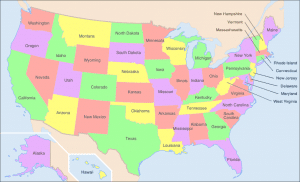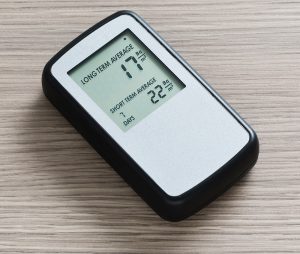Radon is a cancer-causing, radioactive gas
Radon is a naturally occurring radioactive gas released in rock, soil, and water from the natural decay of uranium. While levels outdoor air pose a relatively low threat to human health, radon can accumulate to dangerous levels inside buildings. You can’t see, smell, or taste it, but an elevated radon level in your home may be affecting the health of your family.
Exposure to radon is the second leading cause of lung cancer in the United States and the number one cause among non-smokers. The U.S. Environmental Protection Agency estimates that radon causes more than 20,000 lung cancer deaths in the country each year. Only smoking causes more lung cancer deaths. If you smoke and your home has radon, your risk of lung cancer can be higher.
Radon is found all over the United States 
Radon has been found in elevated levels in homes in every state. No area of the country is free from risk. In fact, two homes right next to each other can have vastly different radon levels. Just because your neighbor’s house does not have an elevated level of radon does not mean that your house will have a low radon level. The only way to know if your home is under the EPA action level of 4 pCI/ is to test. High levels of radon in homes usually come from the surrounding soil. Radon gas enters through cracks and openings – such as sump pump lids and plumbing features – on the lower levels of your home. Hot spots include basements, first-floor rooms, and garages, but radon can be found anywhere in your house.
You should test for radon
The U.S. Surgeon General recommends that all homes in the U.S. be tested for radon. Testing your home for radon is easy to do. If your home has a radon problem, you can take steps to fix it to protect yourself and your family.
Basic Radon Facts
You can find out if your home has an elevated radon level by conducting a simple test. It’s as easy as opening a package, placing a radon detector in a designated area, and, after a set number of days, sending the detector back to a lab for analysis. The lab will then inform you of your radon test results.
Radon test kits are available at your local home improvement or hardware store, or in some cases from your state radon office. You can also order them form Kansas State University (National Radon Program Services) or radon testing companies. Another option is to hire a qualified tester to do a radon test for you. Contact your state radon office about obtaining a list of qualified testers. Information about testing your home for radon and finding a test kit is also available by calling 1-800-SOS-RADON.
Radon is measured in picocuries per liter of air (pCi/L), a measurement of radioactivity. EPA and the Centers for Disease Control and Prevention recommend that homes with radon levels at 4 pCi/L or higher should be fixed. EPA also recommends that Americans consider fixing their homes for radon levels between 2 pCi/L and 4 pCi/L. Based on a national residential radon survey completed in 1991, the average indoor radon level is about 1.3 pCi/L in the United States. The average outdoor level is about 0.4 pCi/L.
You can fix a radon problem!
The cost of making repairs to reduce the radon level depends on several factors, including how your home was built. Most homes can be fixed for about the same cost as other common home repairs, like painting or having anew water heater installed. The average cost for a contractor to mitigate radon levels in a home is about $1,200, although costs can range from $800 to approximately $2,500. Look in your local phone book or call your state radon office to locate radon mitigators in your area if you find an elevated radon level in your home.
New homes can be built with radon-resistant features
Radon-resistant construction methods can be effective in reducing radon entry. When used properly, these simple and cost-effective techniques can help reduce the accumulation of radon gas in homes.
Every new home should be tested after occupancy, even if it was built using radon-resistant construction methods. If radon levels at or above EPA’s action level of 4 pCi/L are detected, it is easier and less expensive to reduce radon levels in homes that have been built with radon-resistant construction techniques.
~~~~~~~~~~~~~~~~~~~~~~~~~~
For more information:
1-800 Numbers
South Dakota Radon Information Line 1-800-GET-DENR (1-800-438-3367)
National Radon Information Line 1-800-SOS-RADON (1-800-767-7236)
Radon FIX-IT Program 1-800-644-6999
Web Sites
DENR Radon Site – https://denr.sd.gov/des/aq/radon1.aspx
US EPA Radon Home Page – https://www.epa.gov/radon/index.html
Kansas State University – https://sosradon.org/
~~~~~~~~~~~~~~~~~~~~~~~~~~~~
The Amy Stockberger team offers the highest level of service in creating a smooth transaction which is made possible by using the array of systems and checklists that have been developed with years of experience and knowledge. With the best technology available, The Amy Stockberger Team surpasses their competition and is consistently dedicated to making their client’s goals their number one priority. Call us today and put the top real estate team in Sioux Falls to work for you!
3220 S. Western Ave. Sioux Falls, SD 57015
(605) 376-6780







I didn’t realize that all homes need to be tested for radon. I had no idea it was so common. My wife and I are preparing to buy a home, and we want to make sure we are totally prepared. I will make sure we find somebody to test it for radon for us, thanks for sharing!
I never knew that radon causes more than 20,000 lung cancer deaths in the country every year! My husband and I recently bought a new home and want to be sure we have it tested and inspected for any and all potential issues. Hopefully we can find a great company in our area who can test for radon in the house and remove it if necessary.
It’s interesting to know that radon is a naturally occurring radioactive gas released in rock, soil, and water that can accumulate to dangerous levels inside buildings. My mother’s neighbor had his house tested for radon, and we are looking for advice about it. I will let my mother know about your article to help her decide about testing our house as well.
I like what you said about testing your home for radon being easy to do. My brother has been telling me about how he wants to make sure that his family is safe from radon in the coming weeks. I’ll share this information with him so that he can get his home tested.